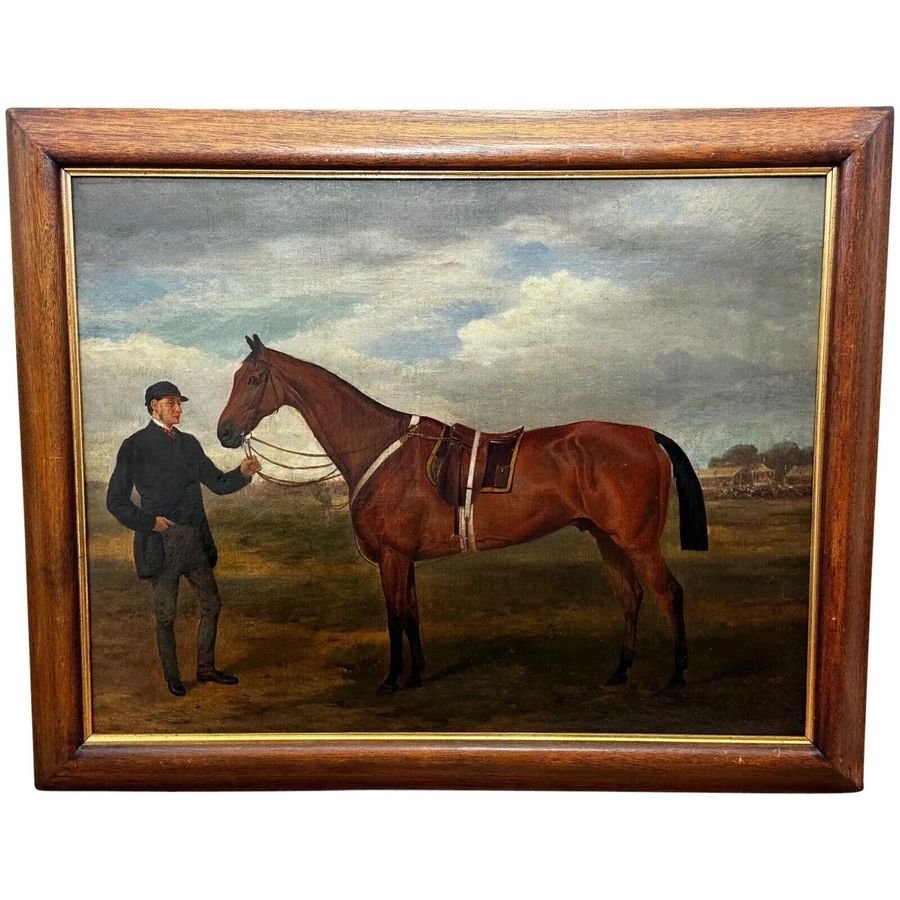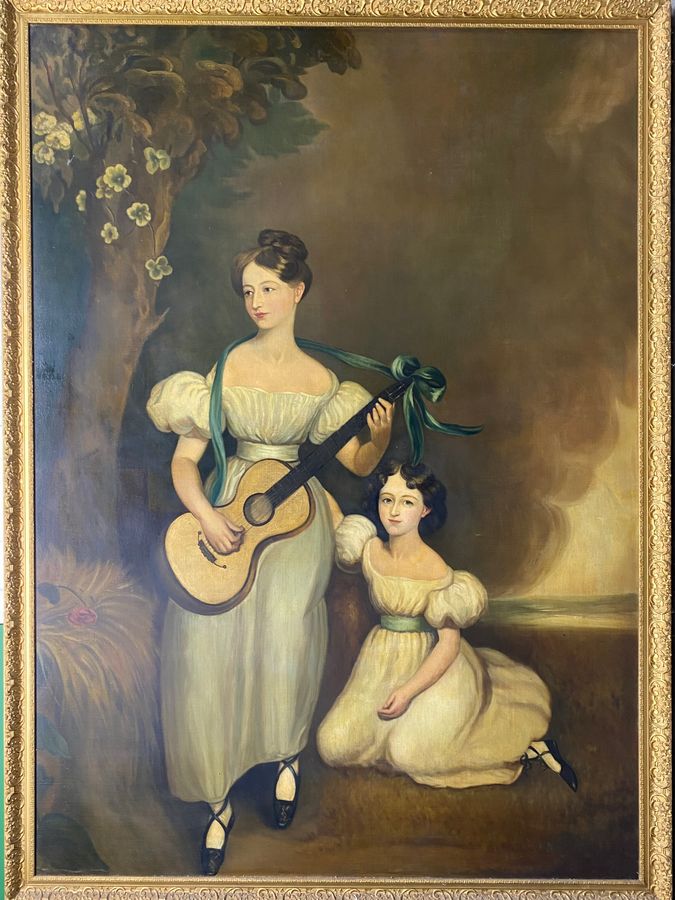We present this religious painting oil on canvas with an original carved and gilded frame, from the 16th century.
It is an oil on canvas stretched over a frame without thicknesses with a gilded and carved frame.
Technically the work can be inserted in the XVI century for the type of canvas and rudimentary frame, without thicknesses and the representation of the figures still hierarchized and little naturalized, it is a painting prior to the Baroque period of the XVII century.
It is attributed to the workshop of Juan Fernandez de Navarrete known as "The Mute" as a work of popular character.
The painting fits into a wooden frame carved with floral motifs and completely gilded. Due to its adaptation to the frame it is the original frame designed to form part of this work. Equally for its technical and aesthetic characteristics we can frame it in the sixteenth century in a period of transition between the altarpieces and the painting of "easel", the carved wooden frames had a decoration very similar to that of the altarpieces with still less refined ornamental motifs.
Iconographically it is represented to Christ as Ecce Homo at the moment in which he was chastised with lashes and expects his crucifixion thoughtfully. It was called "pensive Christ" and its representation in the course of history as "contemplative Jesus, sitting with his head supported by his hand with the crown of thorns and signs of his flagellation" was very common
In the painting the Christ is in a cell with a barred window with an olive branch (a sign of peace and love) in his left hand resting on his leg, the sacred tunic surrounding his back and his pelvis extending to the ground, the head is low like the weeping gaze and rests on the right hand.
We can see how the wounds extend over his body with the blood stains masterfully depicted.
On the left the two angels: a seraph and a cherub praying at his side, probably the same ones represented in other works of the fifteenth century as "La Pietà" by Andrea Mantegna that support the Christ.
Cleaning and restoration by Dr. Eva Moreno Serrano graduated from the University of Seville - Faculty of Fine Arts Santa Isabel D'Ungheria, Master in Creation and Communication Cultural Projects of the Chamber of Commerce Toledo and European Master in Art, Culture, Conservation and Management of Cultural Heritage.
The paint is in excellent condition, with no scratches or paint leaks.
A technical restoration report is published, detailed with photos, state of conservation before and after restoration.
Delivery in Portugal, France, Italy, Germany, Belgium, the Netherlands, Switzerland, Austria included in the price.
Delivery in a wooden case.
For more photos and information: do not hesitate to contact me.
Take a look at our social media profiles to read customer reviews and view our shipping packaging
Nicolò Di Giuseppe
Whats App +34 665372671
Antica Roma Anticuario
anticaromatoledo@gmail.com
Instagram: anticaromatoledo
Juan Fernández de Navarrete (Logroño, 1526-Toledo, 1579), called "El Mudo", was a Spanish painter of the Renaissance. Acclaimed by Gaspar Gutiérrez de los Ríos in his General news for the esteem of the arts (1600) as "our Spanish Apelles, excellent on how many painters he poured" and later by Antonio Ponz (1724) as "Spanish Titian", Navarrete was the most important Spanish painter who worked in the service of Philip II in the decoration of El Escorial, naming him painter of the king in 1568.4
The fame of Navarrete el Mudo has continued over the centuries, as evidenced by the so grateful recognition granted by artistic historiography (Fray José de Sigüenza, Gutiérrez de los Ríos, Francisco Pacheco, Lope de Vega, Ponz, Carl Justi. ..), as well as the fact that José Bonaparte, in the process of creating the so-called "Josefino Museum" (1809), included Navarrete among the great Spanish painters, alongside Murillo or Velázquez. His style, debtor of the Venetian school is reflected in some of his most important works.
With Navarrete the Venetian school entered the court and soon their works hung on the walls of the Alcazar of Madrid next to those of Jacopo Robusti "el Tintoretto" and Lorenzo Lotto.
Navarrete el Mudo is usually tied to mannerism because of his studious, expert and eclectic style. His work evolves towards greater drama and the use of chiaroscuro; He is the first Castilian painter who abandons finite forms in search of pictorial solutions based on the application of free brushstroke, the predominance of color over drawing and the dramatic use of light. It does not fully accept the dazzling Venetian color and, adapting to the sobriety of the Royal Monastery of San Lorenzo de El Escorial, adopts a chromaticism of lands and ocher for this type of commission.
His latest works reduce the color palette in brown and black lands. They are characterized by an expressive use of focused light. This is the case of El Burial de San Lorenzo, where the martyr appears in the darkness of a closed night. On his left a boy, taken from El Soplón de El Greco, blows a sore to light the end of a candle. Christ appearing to his mother, another of his last paintings, shows a resurrected Christ with his body illuminated in a dynamic composition. In the line of the last Titian and foreshadowing tenebrism, his last years show that Navarrete was at the height of his art when a premature death arrived.
Antiques.co.uk Ref: BJDQ9B23
- Maker/Artist:
- Juan Fernandez De Navarrete Workshop (1526-1579)
- Width (cm):
- 30
- Height (cm):
- 27
Here on antiques co uk we love antiques and specialise in selling antiques. Even though this item was for sale and is now sold or otherwise now unavailable we have many more items for sale including vintage antiques, silver, tables, watches, jewellery and much more for your interiors and home.
Search all the antiques currently for sale on www.antiques co uk. Or why not consider selling your antiques and making sales more easily with us!

![19th Century Oil Painting Bay Hunter Horse With Groom At Fair C1863]() £15000.00
£15000.00![Pair of Oil on Canvas Portraits of the Chandos-Pole Family C.1825-1830]() £20000.00
£20000.00![Large Naval Portrait Captain Gamaliel Nightingale By John Simmons The Younger]() £15000.00
£15000.00![17th Century Oval Painting Boy with King Charles Spaniel Puppy Circle Of Mary Beale]() £14000.00
£14000.00










